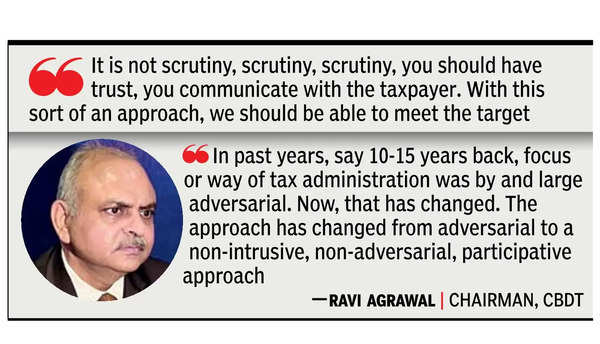The tax department has renewed its focus on simplification and is banking on trust. In an interview to TOI, chairman of the Central Board of Direct Taxes (CBDT) Ravi Agrawal says he is confident that direct tax revenues would remain robust, making it easier for the department to meet this year’s target. Excerpts:
CBDT is now the focus as evident from Budget announcement. How do you see this?
It’s a matter of great satisfaction that this time the Budget has been taken so positively and the taxpayers are happy. If taxpayers are happy, we are happy.
Given the uncertainty and slowdown in the economy, how do you see the revenue numbers?
The entire benefit is about Rs 1 lakh crore and the Budget target this year is Rs 22.37 lakh crore, so it makes 5% of total taxes. Therefore, the number of taxpayers is more. Ultimately, impact of this Rs 1 lakh crore being in the hands of people will have an impact on the economy. Business would develop. Once that is positive, then the economy also grows. Once it grows, it has a positive implication on tax revenues. So, it will come back. It will come through companies, it will come through business income, it may come through salaries because if companies grow, salaries would also grow. There would be a positive spin-off of this Rs 1 lakh crore relief. We are now growing at 15% this year because of this relief and the Budget target is kept at 12.46%. Therefore, there is a margin of about 2-2.5%, which we have factored in.It is not scrutiny, scrutiny, scrutiny, you should have trust, you communicate with the taxpayer. With this sort of an approach, we should be able to meet the target.

Now, 1 crore taxpayers will benefit after the Budget announcement. What would be total number of taxpayers?
There are two components. One is to avail this benefit, the taxpayer has to file a return and then if a refund is due that person would take the refund. Therefore, the number of returns would by and large remain the same. That would be about 9 crore. The rebate was available to Rs 7 lakh income and below, now it’s Rs 12 lakh. One can say, for a crore-and-a-half taxpayers, who were in this bracket (Rs 7 lakh to Rs 12 lakh), it would be a zero-tax liability. The actual number of taxpayers would be around 3 crore.
How has approach of the tax department changed with regard to the taxpayer?
We are adopting a different approach altogether. Revenue is part of the economy’s growth. It is not to be seen in isolation. It has to have a supportive role because any tax is basically a derivative of the income or the economic activity. So, it has to be in harmony with economic growth. And, if economy grows, tax buoyancy would be there. That factor would be there. In past years, say 10-15 years back, the focus or way of tax administration was by and large adversarial. Now, that has changed. The approach has changed from adversarial to a non-intrusive, non-adversarial, participative approach. I have given some message to my officers within the department. We are actually working towards adopting a prudent approach.
Focus of the tax department has been on simplification and a new bill will be introduced to revamp the IT Act. What are the changes?
It would be simplification in terms of language, simplification in terms of presentation and the thought behind is this is a 1961 Act. You find at times that the articulation, sentences are not so user-friendly, they are not simple and make it difficult for the taxpayer to actually comprehend the provisions. Due to this, there is some sort of confusion and there is some sort of hitch on part of the taxpayer. Perhaps that dissuades the taxpayer from compliance. That leads to litigation. Keeping that in mind, the attempt is we rephrase those sections in simple English language so that it is easy for people to comprehend. It brings more clarity to the system and therefore it will reduce litigation. Size of the document has substantially come down.
